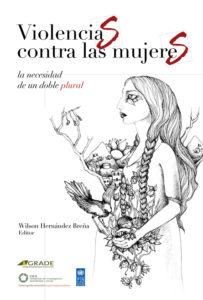Violencias contra las Mujeres: La necesidad de un doble plural
| Year | : | 2019 |
|---|---|---|
| Author/s | : | Wilson Hernández, César Nureña, Cecilia Caparachín, Jhon Ortega, Rosa Luz Durán, Erika Janos Uribe, Agustín Espinosa, Marieliv Flores, Claudia Serna, Rosa Cueto, Carolina Arrunátegui, Lilian Kanashiro, Lucía Yap, Cecilia Núñez, Manuel Martín, Sydney Silverstein, Rosario Rodríguez, Willy Guevara, Andrea Cabel García, Luis Bustamante Otero, Maribel Arrelucea, Paloma Rodríguez |
| Area/s | : | Ethnicity, gender and citizenship |
Hernández, W. (Ed.) (2019). Violencias contra las Mujeres: la necesidad de un doble plural. Lima: GRADE y PNUD.
Peru is among the countries with the greatest violence against women in the world. According to official figures, seven out of ten women in our country have suffered psychological, physical and / or sexual violence from their partner at some time in their life. This proportion conceals a complex reality that needs to be revealed: a double plural that incorporates in the discourse and practice the different violence that is exercised against women.
Multiple violence: not only physical and sexual aggressions, but also those normalized and symbolic that are linked to stigmas, stereotypes and forms of segregation and discrimination. Women: victims of violence affected by certain intra-group conditions such as age, ethnicity, sexual orientation, class, among others.
Written by authors from various disciplines, this book brings together fifteen chapters linked by two conductive threads: they point out both the structure and the individuals as responsible, and highlight the presence of sexist patterns (perceptions, attitudes and behaviors of men and women, institutions and spaces ) as partial or total culprits.
That double plural, of multiple violence and women, is to aim to eliminate and to which this text aims to contribute.
INDEX
Introduction
The need for a double plural
Wilson Hernández Breña
Violence in relationships
Chapter 1
Not one, but several ways of being a victim: Patterns of victimization in relationships
Wilson Hernández Breña
Chapter 2
Why don’t you leave violent men? Social and cultural aspects linked to maintaining relationships in women affected by partner abuse
César Nureña and Cecilia Caparachín
Chapter 3
Why women victims of partner violence in Peru do not seek help?
Jhon Ortega
Chapter 4
More educated, more empowered? Complementarity between schooling and employment in the probability of domestic violence against women in Peru
Light Pink Durán
New contexts for old problems
Chapter 5
“These things not happened to a lady …”: Sexism and blaming the victim in comments on social networks before a news of sexual violence occurred in Lima
Erika Janos Uribe and Agustín Espinosa
Chapter 6
Gender and public space: street sexual harassment as a sign of manhood
Marieliv Flores
Chapter 7
Ambivalent sexism and unfavorable attitudes towards female leadership in a school of noncommissioned officers of the Peruvian army
Claudia Serna and Rosa Cueto
Chapter 8
When the medicine is worse than the disease: Tomás Angulo’s love self-help speech and gender violence in Peru
Carolina Arrunátegui
Chapter 9
Journalistic enunciation of adult feminicide: The case of Paola Peralta
Lilian Kanashiro and Lucia Yap
A critical look from the Amazon
Chapter 10
Suicides in the days of coca: gender, violence and social changes in Ticuna communities of the Peruvian Amazon
Cecilia Núñez, Manuel Martín, Sydney Silverstein and Rosario Rodríguez
Chapter 11
The resource of poisoning: Violence and gender in the Awajun culture
Willy Guevara
Chapter 12
La Selvática of La Casa Verde: beyond the violence of
stereotype and stigma
Andrea Cabel García
The multiple violence in history
Chapter 13
Puberty and marriage choice. The city of Lima and the experience of marital brutality in colonial agony
Luis Bustamante Otero
Chapter 14
Sleeping with the enemy? An exploratory study on violence, family and marriage between Africans and Afro-descendants. Lima at the end of the colonial period
Maribel Arrelucea
Chapter 15
“Extirpation of Idolatries” and violence against indigenous women in the colonial Andes, 16th century
Paloma Rodríguez






